IJCRR - 4(8), April, 2012
Pages: 63-76
Date of Publication: 25-Apr-2012
Print Article
Download XML Download PDF
EXPERIMENTAL BEHAVIOUR OF A PYRAMID TYPE SOLAR STILL COUPLED AND DECOUPLED TO AN ELECTRICAL TEMPERATURE CONTROLLER
Author: S.Kalaivani, S.Rugmini Radhakrishnan, B.Selvakumar, M.Indhumathy
Category: General Sciences
Abstract:In this communication, an experimental investigation of the behaviour of a pyramid type solar still coupled and decoupled to an electrical temperature controller unit has been presented. The main advantage of the pyramid type solar still is that the maximum radiation can penetrate inside the basin from electrical temperature controller. The main objective oh this present paper is to study the behaviour of the still performance with and without of electrical temperature by analyzing the internal and external heat transfer co-efficient.In general the still performance is reasonable with a good daily output including nocturnal output. The addition of electrical temperature controller where capable of enhancing the productivity with heat retention causing continued evaporation
Keywords: Solar still, water collection, and temperature controller.
Full Text:
INTRODUCTION
Mahmoud I.M. Shatat and K. Mahkamov (2010) described the performance of a multi stage water desalination still connected to a heat pipe evacuated tube solar collector with aperture area of 1.7 m². The multi stage solar still water desalination system was designed to recover latent heat from evaporation and condensation processes in four stages. V.K. Dwivedi et al., (2008) has made an attempt to evaluate the internal heat transfer coefficients of single and double slope passive solar stills in summer as well as winter climatic conditions for three different water depths (0.01, 0.02, and 0.03 m) by various thermal modes. The experimental validation of distillate yield using different thermal models was carried out for composite climate of New Delhi, India (latitude 28º35‘ N, longitude 77 º12‘E). By comparing theoretical values of hourly yield with experimental data it has been observed that Dunkle‘s model gives better agreement between theoretical and experimental results. Dunkle‘s model has been used to evaluate the internal heat transfer coefficient for both single and double slope passive solar stills. With the increase in water depth from 0.01 m to 0.03 m there was\a marginal variations in the values of convective heat transfer coefficients. It was also observed that on annual basis output of a single slope solar still is better as compared with double slope solar still. M.K. Phadatare et al., (2007) made an attempt to study the effect of water depth on the internal heat and mass transfer in a single basin single slope plastic solar still. The experimental still was fabricated from Plexiglas. The bottom and ll sided of the still are made from a sheet of black Plexiglas. The cover is made from a transparent Plexiglas of the same thickness. The solar still was sealed to reduce the leakage of vapour to the surroundings. The study covers the influence of different environmental and operational parameters on the still productivity. The operational parameter such as depth of water in the basin is varied from 2 cm to 12 cm to find out its influence on internal heat and mass transfer and hence the productivity of the still. The maximum distillate output of 2.1 L/m2 /day was obtained with water depth in still basin 2 cm. The maximum efficiency of the experimental still varied from 10% to 34%. The results indicated that with increase in depth of basin water, still productivity decreases Salah Abdallah et al., (2007) developed an experiment work to improve the single slope solar still performance through increasing the production rate of distilled water. Design modifications were introduced to the conventional solar still, involving the installation of reflecting mirrors on all interior sides, replacing the flat basin by step-wise basin, and by coupling the conventional solar still with a sun tracking system. The inclusion of internal mirrors improved the system thermal performance up to 30%, while step-wise basin enhanced the performance up to 180% and finally the coupling of the step-wise basin with sun tracking system gave the highest thermal performance with an average of 380%. The accumulated production of the deep-basin solar still and that of the tilted tray solar still with longitudinal baffles are compared by Badawi W.Tleimat et al., (2003). The comparisons show that evaporation in the deep basin still continues during the entire 24 hour period while the tilted tray still ceases to produce a relatively short time after sunset. Thus nocturnal production is maximum for the deep basin type and nearly zero for the tilted tray still is studied. A small experimental still was constructed to determine the factors affecting the nocturnal production of solar stills. The experimental results indicate that a substantial increase of product water could be obtained from the continuous addition of warm water to the still. This increase was found to be a function of flow rate, feed-water temperature, evaporating and condensing areas and ambient temperature. Nikola Nijegorodor et al., (2003) described two solar thermal –electrical methods to purify water by distillation. In this first method air saturated with water vapour is removed from a basin type still by using a low power exhaust fan, and is passed through a condenser where the latent heat of water vapour is used to pre heat the mineralized water for the basin. This also results in lower temperature for the glazing and a faster rate of evaporation from the basin. The net effect in an increased thermal efficiency of the still more than twice the thermal efficiency of the conventional still. In the second design a condenser collector is used to boil water in the absorber tube. A low power vacuum pump is employed to lower the boiling temperature of water by about 10ºc. The yield of distillate from the still is nearly double. M.Boukar and A. Harmim (2001) has studied the effect of desert climatic conditions on the performance of a simple basin solar still and a similar one coupled to a flat plate collector. A three months round study showed that the productivity of the simple basin and similar coupled to a flat plate solar collector strongly depends on the solar radiation and ambient temperature The effect of intermittent flow of waste hot water in the basin of solar stills on its performance has been discussed by Madhuri et al., (2001) as well as the effect of various parameters- duration of flow of hot water, flow rate and water depth. It is concluded that for higher yield, the waste hot water should be fed into the basin during off-sunshine hours. The results have also been compared with those of Tiwari and Malik and sodha et al. A single basin solar still with basin area of 0.98*0.98 m was constructed from galvanized iron sheets and an inclined glass cover. The still was provided with 525 W electrical heating tapes, fixed under the still for indoor steady state operation. The variations of basin temperature and evaporation rate were measured during both indoor and outdoor operation. Transient analysis of the still requires the evaluation of evaporative, convective and radiative heat transfer coefficients. The Dunkle model, which has been widely used for the prediction of the evaporative coefficient, was found to be over predicting evaporation rates. The models developed in this work were found to provide better prediction for the evaporation rate measured in this work and this work was investigated by Ahmad Taleb Shawaqfeh et al., (2000). A techno-economic analysis of multi-stage stacked tray (MSST) solar still coupled with a solar collector through a heat exchanger has been developed by R.S. Adhikari et al., (2000). The study also includes a discussion on the sensitivity of cost of unit mass of distilled water in references to the useful life of distillation chamber, cost of solar collector and other associated parameters. Faten H. Fahmy et al., (1998) has presented a new way to realize continuous operation of a solar desalination system to produce fresh water using solar energy for a dual purpose. To realize the continuity of still operation daily and overnight, the batteries are discharged during the night at a suitable rate to feed an electric heater. The electric heater is designed to generate the required heat for desalination during the night. This modified still is provided with a packed bed layer installed in the bottom of the basin to assist the system during the day and at night, i.e., this modified still will be more efficient. The use of PV and packed bed systems means higher efficiency than the passive still, as the modified still produces large quantities of fresh water in August for a saline water depth of 0.01 m by using glass wool insulation 0.05 m thick and glass spheres as a packed bed with 0.0213 m bed length. Multiple linear regression equations relating to ambient, air temperature, wind speed and solar radiation were developed by A.N. Minasian et al., (1992) to estimate the productivity of a still. The study shows that condensation process inside the stills is achieved during the period between sunset and sunrise. Results reveal that the average wall‘s contribution in supplying fresh water is about 56%, whereas base contribution is about 31%. It is concluded, therefore, that setting many stills on a number of separated holes will give higher output rather than setting a single still on one large hole of the same volume. H.M. Ali (1991) has been studied a mathematical model to predict the performance of the solar still using forced convection inside the solar still to enhance the productivity of the still. It shows that the productivity increases about 60% more than that of a natural convection solar still. Good agreement between the theoretical and experimental results is obtained. Enhancing mass transfer co-efficient due to forced convection has a major role in the productivity enhancements. S.A. Lawrence and G.N.Tiwari (1991) have been studied the thermal modeling based on heat and mass transfer relations of a green house integrated with a solar still. An experiment was carried out for a typical greenhouse in Port Moresby. The following observations were made. (i) There is a reasonable agreement between theoretical and experimental results and (ii) the amount of distilled water obtained is sufficient to grow the plants‘ inside the greenhouse.
2. Construction details for both pyramid solar still and temperature controller Pyramid solar still of base area 0.85m x 0.85m is designed. The still is filled with the water to a height of 0.05m. Top of the system is covered by a 3 mm transparent glass pyramid cover with a height of 0.30m at the middle. It is air tightened using the cushion supports at the interface between the top cover and the sides of sliding support for uniform landing. Bottom of the still is insulated using sawdust, while the side is insulated with glass wool. The specification of different parts of the still is given below.
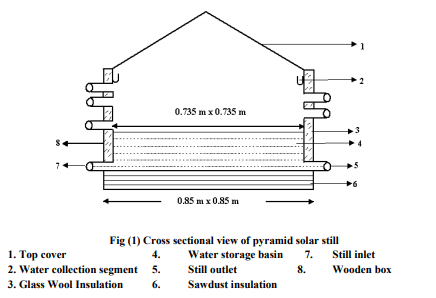
2.1 CONSTRUCTION OF ELECTRICAL TEMPERATURE CONTROLLER
Electrical backup made up of Temperature controller, Heater coil and Thermocouple. Temperature controller has various plug-in from number 1 to number 20. For temperature controller setting plug-in 1, 2, N1, C, N0, 12 and 13 are used. Temperature of the controller unit can be kept at any temperature by using set key function (4 digit display), which has two buttons to increase and decrease the temperature. Connections from plug-in 2 and C are interconnected and used as one end of input power supply. Pug-in 1 is used as another end of power supply input. Also a connection is taken from Plug-in 1 and it is connected to one end of the coil. Plug-in N0 is connected to another end of coil. Pluginn‘s 12 and 13 are connected to thermocouples. Heater coil is made up of stainless steel and is placed inside the solar still. Sensor thermocouple should be placed near to the heater coil. Schematic representation of electrical backup circuit with temperature controller is shown in Fig (3.2).
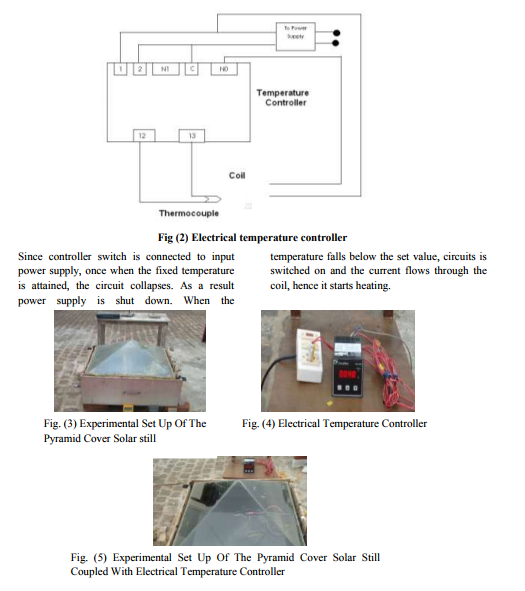
The physical and chemical analysis for the tap water and distilled water were made at the Regional Laboratory of Tamil Nadu Water Board (TNWB), Coimbatore. The samples were tested for colour, turbidity, total dissolved solids, electrical conductivity, pH, alkalinity chloride, fluoride, sulphate, phosphate and the results are tabulated in the tables (3.17-3.18)

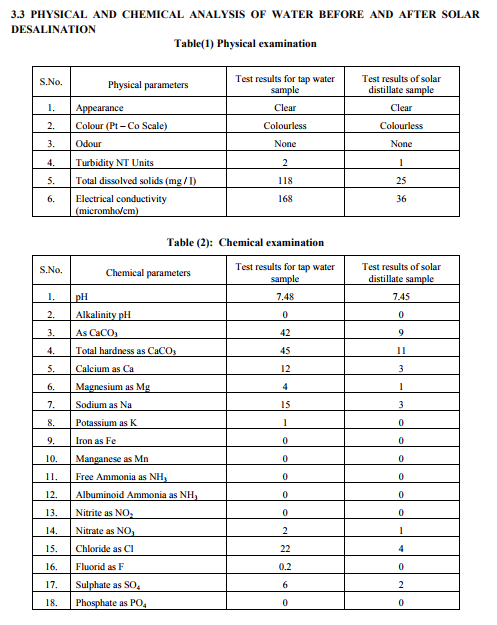
3.4 Techno – Economic Analysis The simple techno – economic analysis (Tiwari and Yadav, 1987) of the effectiveness of solar distillation systems considers the capital cost of the system ?P‘ and the rate of capital recovery ?C‘. The first annual cost of the system A can be determined by the following formula.

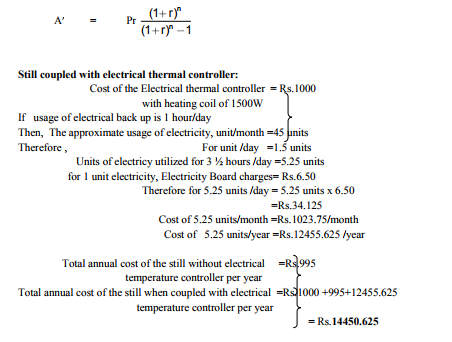
The distillate output yield for both solar radiation utilizing solar still and still with electrical temperature controller is more or less same. But the Cost of the solar still utilizing electricity for evaporation is 15 times greater than that of the solar still with the use of solar radiation. This analysis shows that solar still which is exposed to solar energy is highly economical and profitable. Graphical Analysis The graphs are plotted between the various observed parameters such as solar insolation, efficiency, distillate output, temperature profiles of various junctions etc, during selected sunny days of experimentations.
Fig (4.1) shows the variation of temperature profiles with time, still decoupled with electrical thermal controller. The cover temperature of the still increases as the day progresses because of the increased evaporation of water from basin and consequent condensation of water vapour at the bottom surface of the top cover. Ambient temperature variation depends on atmospheric condition. The temperature of water and glass cover increases in the morning hours to maximum values around noon time before they start to decrease late in the afternoon. This is due to the increase of solar insolation in the morning and the decrease in the afternoon. Distillate output with respect to time increases in the morning and then decreases in the afternoon because of varying solar insolation. It is found out in the Fig (4.2) The variation of insolation with respect to time shown in the Figure (4.3) it increased linearly with time and reached the maximum value from 12 noon to 2 p.m. and then decreased. Radiation received during this study is in the range of 0 to 1200 W/m2 The variation of the average efficiency with respect to no. of days is drawn in Figure (4.4) Average efficiency is varied according to solar insolation and water collection for different days. Figure (4.5) shows the variation of the average insolation with respect to no. of days. Average insolation is varying for different days. The water temperature and distillate output with respect to time decoupled with electrical thermal controller is shown in fig (4.6). Water Temperature and the distillate yield increases in the morning hours and starts to decrease late in the afternoon because of decrease in solar insolation Figure (4.7) shows the variation of temperature profile and distillate output with respect to time decoupled with electrical thermal controller. Temperature and the distillate yield increases in the morning hours and starts to decrease late in the afternoon because of decrease in solar insolation. Figure (4.8) shows the histogram for water temperature with respect to distillate output for the Pyramid still decoupled with electrical thermal controller. Figure (4.9), (4.10), (4.11) shows the histogram for water temperature with respect to distillate output for the Pyramid still coupled with electrical thermal controller. The histogram for water temperature with respect to distillate output for the Pyramid still decoupled and coupled with electrical thermal controller is found out Table (3.15) .This shows that both studies give approximately distillate output for corresponding temperatures. In general Still performance which is decoupled with electrical thermal controller is reasonable with a good daily output. The still coupled with electrical thermal controller is cost effective, even though it gives daily output similar to the conventional still. CONCLUSION Solar still with pyramid cover is investigated for its performance in this study for a number of days. Temperature profiles of water, ambient, cover, air, absorbent, amount of distillate output including nocturnal output were observed. The performance of the still with and without electrical thermal controller is analyzed, for augmenting the productivity. The instantaneous and daily efficiency were calculated. Heat transfer coefficients were computed. Numerical calculations are carried out for comparing the observed values of heat transference with theoretical values. Techno economic analysis is estimated for the system reliability. The quality of distilled water yield is examined by a physical and chemical properties test carried out on a collected sample of water in the Regional Laboratory, Tamilnadu Water Supply and Drainage Board, Coimbatore.
References:
1. Dwivedi V.K. Tiwari G.N. (2008), Comparison of internal heat transfer coefficients in passive solar stills by different thermal modes: An experimental validation , Desalination, Vol. 246, Issue. 1- 3, Pp 304-318
2. Phadatare M.K. and verma S.K.(2007), Influence of water depth on internal heat and mass transfer in a plastic solar still, Desalination, Vol. 217, Issue.1-3, Pp 267- 275
3. Salah Abdallah, Omar Badran and Mazen M. Abu-Khader(2007), Performance of a modified design of single slope solar still, Desalination, Vol. 219, Issue 1-3, Pp 222- 230
4. Badawi W. Tleimat and Everett D. Howe (2003), Nocturnal production of solar distillers, Solar Energy, Vol.10, Issue. 2, Pp. 61-66
5. Nikolai Nijegorodov, Pushpendra K. Jain and Stig Carlsson (2003), Thermalelectrical, high efficiency solar stills, Renewable Energy Vol. 4, Issue 1, Pages123-127
6. Boukar M and Harmim A. (2001), Effect of climatic conditions on the performance of a simple basin solar still: a complete study, Desalination, Vol. 137, Issue. 1-3, Pp. 15-22
7. Madhuri and Tiwari G.N.( 2001), Performance of solar still with intermittent flow of waste hot water in the basin, Desalination, Vol. 52, Issue 3, Pp. 345-357
8. Ahmad Taleb Shawaqfeh and Mohammed Mehdi Farid (2000). New development in the theory of heat and mass transfer in solar stills, Solar Energy Vol. 55, Issue 6, Pp. 527-535
9. Adhikari R.S. Ashvini kumar and Grag H.P. (2000) ,Techno- economic analysis of a multi- stage stracked tray(MSST) solar still, Desalination, Vol. 127, Issue.1-1, Pp 19-26
10. Faten H. Fahmy (1998), Efficient Design of Desalination System Using Photovoltaic and Packed Bed Systems , Energy Sources, Part A: Recovery, Utilization, and Environmental Effects, Vol. 20, Issue 7 , Pp 615 – 629
11. Minasian A.N., Al-Karaghouli A.A., Hasan M. and Shakir A. (1992), Utilization of solar earth waterstills for desalination for ground water, Energy conversion management, Vol. 49, Issue 2, Pp 107-110
12. Ali H.M. (1991), Mathematical model of the solar still performance using forced convection with condensation process outside the still, Energy conversion management, Vol. 1, Issue 5/6, Pp. 709-712
13. Lawerence S.A. and Tiwari G.N. (1991), performance of a green house cum solar still for the climatic condition of Port Moresby, Energy conversion management, Vol. 1, Issue. 2, Pp. 249-255
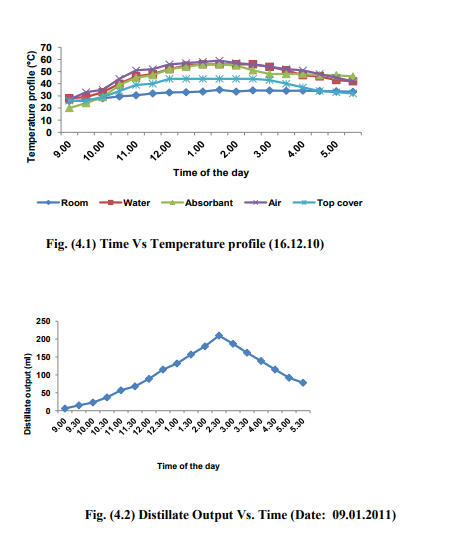
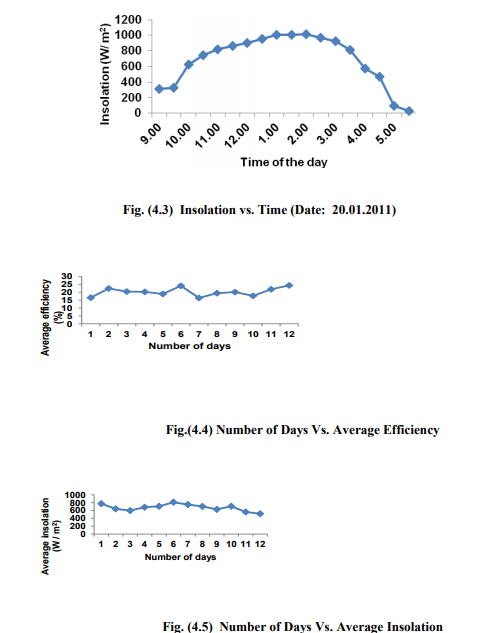
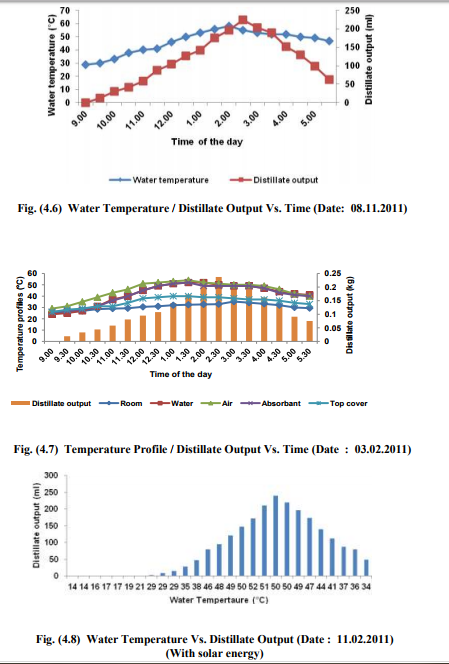
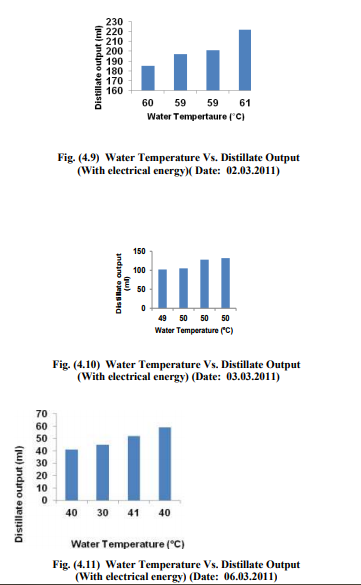
|






 This work is licensed under a Creative Commons Attribution-NonCommercial 4.0 International License
This work is licensed under a Creative Commons Attribution-NonCommercial 4.0 International License